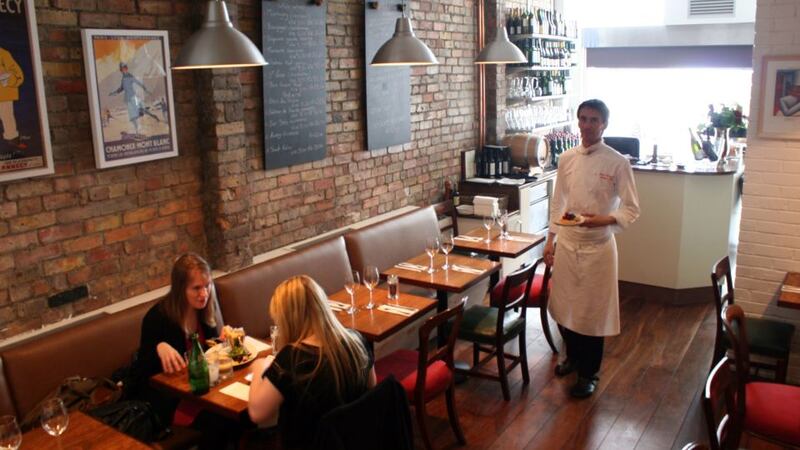Newly arrived in Ranelagh, La Réserve is almost cartoonishly French, but its chef-proprietor Jérôme Fernandes is deadly serious about fine French cuisine, writes CATHERINE CLEARY
BOOZE, BUTTER AND GARLIC are the holy trinity of the world’s most successful restaurant food. Fry shallots and garlic in a melted knob of golden butter, add a glass of white wine and let the fragrance fill your kitchen. Instant French restaurant aroma, eau de yum. Of course this is also the base for a perfect risotto but, as any self-respecting Italian will tell you, the Italians invented French food.
In the rush to Nordic foraging, tapas and posh burgers, it’s easy to forget that la cuisine Française hasn’t gone away. It’s been watching all the palaver with a jaded nonchalance through heavy lids with a stiff pastis to hand.

You might be reminded of this the next time you walk through Dublin’s restaurant village, Ranelagh, on a summer’s evening. As I park the bike across the road from its newest arrival, La Réserve Brasserie, wafts of buttery, garlicky meatiness are coming from the small, dark-painted shopfront that’s easily missed by the eye but sticks out a mile for Bisto kids who follow their noses.
The restaurant used to be Ochos, a narrow tapas joint in which I once had a stuffy, cramped and disappointing meal. Now it’s got chocolate-box French prints framed on the walls, a mismatched set of auction-house dining-room chairs and a jaunty Eiffel Tower painted in white on the window, in case anyone had any doubts. It’s almost cartoonishly French. All that’s missing is an imperious mâitre d’ in starched white apron winding his waxed moustache ends haughtily. And in this Dublin village, where new restaurants are springing up all the time, its Frenchness is its calling card.
The place feels a little bigger than previously, and some outside tables have been added. Inside, the tables are bare, and candles give it a cosy feeling as summer dusk falls. The menu gives each dish its French name in bold capitals followed by an English translation in lower case.
The chef here is Burgundy-born Jérôme Fernandes, who trained in France with two-star chef Jean-Marc Delacourt and then came to Ireland in 1997. He worked in Conrad Gallagher’s Peacock Alley in the 1990s and then headed to the posh US hotel scene with the Ritz Carlton group. Now he has taken the step which must be the dream of many hotel chefs: he’s opened his own place.
We start with excellent bread and a balsamic and olive oil pot for dipping. It’s such a no-brainer to give your customers something to chew on as they settle in. The service is friendly and Fernandes tours the small dining-room after service to get his diners’ reactions. The food is not cheap; most mains breach the psychological €20 barrier. But the reaction is good. A prawn starter sees juicy prawns fried in pastis and garlic, crisply flambeed, and left cloaked in aniseedy buttery flavour.
A tiny hatch-sized pass separates the dining area from the small kitchen at the back. Nothing seems to stay there too long to die a small death under the heat lamps.
I get a bowl of delicately floured and fried calamari, which are nicely chewy rather than elastic-bandish. They come with a gorgeous blended red pepper sauce.
Main courses are equally competent. Seabass has had more pastis and butter in its sauce and is perfectly cooked. Excellent skin-on chips come in a tin bucket. Green beans are served in a piping hot cast-iron skillet with lardons and toasted almonds to take the healthy look off them, and another shiny slick of melted butter.
I get loin of lamb cut into two slightly fatty pieces with a potato gateau, which consists of a cake of thinly-sliced potatoes baked in a shallow dish, around a middle consisting of finely-chopped ratatouille ingredients.
We drink a bottle of Tariquet, a blended Languedoc white (€27.50). Unsurprisingly, it’s an almost entirely French wine list.
The desserts move to the other holy trinity: booze, butter and sugar. A light, fluffy crepe with booze-soaked apples takes on the influences of Brittany with the addition of Calvados to the caramel sauce. A chocolate tart has a more biscuity base and cheesecake appearance than I would have expected, but is delicious, in that grown-up, bitter chocolate way.
Two robust coffees (though one is decaf) round it off perfectly. Like the striped Breton top, there’s nothing groundbreaking or startlingly different happening here, just classic French cooking. And some nights, that’s all you need.
Dinner for two with wine, sparkling water and coffees came to €123.45.








